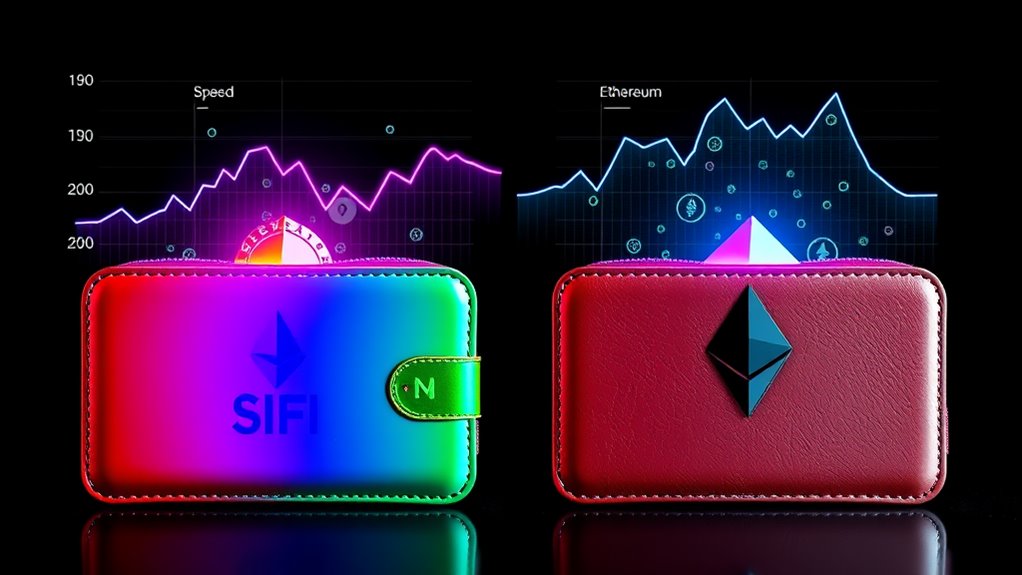
Bitcoin Vs Ethereum Gas Fees Compared
Bitcoin and Ethereum differ greatly in their approaches to transaction fees. Bitcoin fees are primarily determined by transaction size and network congestion, incentivizing miners to validate transactions. In contrast, Ethereum employs a dynamic fee structure based on gas units and fluctuating prices, influenced by network demand and transaction complexity. Both platforms experience increased fees during periods of high congestion. Understanding these differences can provide insight into how transaction costs evolve, revealing deeper nuances in each network’s structure.
Table of Contents
Key Takeaways
- Bitcoin transaction fees vary based on size and network demand, incentivizing miners for validation.
- Ethereum gas fees are dynamic, influenced by base and priority fees, fluctuating with network usage and transaction complexity.
- High congestion on both networks leads to increased fees due to competition for limited block space.
- EIP-1559 in Ethereum aims for more predictable gas pricing, adjusting fees according to demand.
- Layer 2 solutions are being developed for both Bitcoin and Ethereum to reduce fees and enhance scalability.
Overview of Bitcoin Transaction Fees

Bitcoin transaction fees play an essential role in the functionality and security of the Bitcoin network. These fees incentivize miners to validate and add transactions to the blockchain, creating a revenue source alongside block subsidies.
Initially designed to prevent spam transactions, fees have evolved into a crucial component for network maintenance, especially as block subsidies decrease over time. Transaction fees are calculated based on the size of the transaction and the demand for block space, leading to variability during periods of high network congestion.
Users can prioritize their transactions by setting higher fees for quicker processing, reflecting market demand and conditions. Overall, these fees are imperative for sustaining the network’s integrity and ensuring that miners remain motivated to participate. Additionally, understanding how fees are calculated can help users make more informed decisions regarding their transaction costs.
Understanding Ethereum Gas Fees

Understanding Ethereum gas fees is essential for anyone engaging with the network.
These fees are calculated based on gas units and the gas price, which fluctuates according to network demand.
Factors such as congestion can greatly impact these fees, leading to variations in transaction costs that users must consider.
Gas Fee Calculation Methods
Gas fees on the Ethereum blockchain are essential for facilitating transactions, as they serve as the costs associated with processing and validating these transactions.
These fees are calculated using the formula: Gas fees = (Base Fee + Priority Fee) * Gas Units. The base fee is a dynamic cost that adjusts based on network demand, while the priority fee incentivizes validators to prioritize specific transactions.
Gas units represent the computational resources needed to process a transaction, with a typical transaction using around 21,000 gas units. Prices are measured in Gwei, where 1 Gwei equals 0.000000001 ETH.
Understanding this calculation method helps users estimate transaction costs and plan accordingly, enhancing their experience on the Ethereum network.
Factors Affecting Gas Fees
Although many users may not realize it, several key factors considerably influence gas fees on the Ethereum network. Understanding these elements can help users navigate the costs associated with transactions.
- Network Demand: The popularity of Ethereum and the usage of decentralized applications (dApps) lead to increased demand, raising gas fees.
- Transaction Complexity: Interacting with smart contracts, particularly in decentralized finance (DeFi) and NFT minting, requires more computational resources, which translates to higher gas costs.
- Ethereum Upgrades: Changes like EIP-1559 have introduced mechanisms that adjust fees based on network usage, aiming for greater predictability and stability in gas pricing.
These factors collectively shape the gas fee environment, affecting how users plan their transactions on the Ethereum blockchain.
Impact of Network Congestion
Network congestion plays a significant role in determining transaction fees on the Ethereum blockchain. When the demand for transactions exceeds the network’s capacity, gas fees rise due to competition for limited block space.
This is particularly noticeable during high-traffic events, such as NFT launches or surges in decentralized finance (DeFi) activity. Users can expedite their transactions by paying higher fees, but this can lead to significant costs during peak congestion.
Unlike Bitcoin, where fees are mainly influenced by transaction size, Ethereum’s fees are affected by both transaction complexity and congestion. High gas fees can deter users, ultimately impacting economic activity on the network.
Solutions like Layer 2 technologies aim to alleviate these issues by reducing congestion and costs.
Factors Influencing Bitcoin Fees

Transaction fees in the Bitcoin ecosystem are influenced by several interrelated factors that reflect both the behavior of users and the technical limitations of the network.
These factors contribute to the variability of transaction costs and user experiences, making understanding them essential for anyone participating in Bitcoin transactions.
- Network Demand: Increased transactions raise fees due to limited space in blocks.
- Transaction Size: Larger transactions require more data, leading to higher fees.
- Market Price Fluctuations: Changes in Bitcoin’s price can affect users’ willingness to pay for faster processing.
In addition, Bitcoin’s role in global finance may also shape transaction fee trends as adoption increases and the network evolves.
Factors Influencing Ethereum Gas Fees

The factors influencing Ethereum gas fees are primarily shaped by network congestion and the type of transaction being processed.
During periods of high traffic, such as NFT launches, users experience increased fees due to competition for limited block space.
Additionally, the complexity of a transaction—ranging from simple ETH transfers to intricate smart contract executions—affects the gas required, further influencing overall costs.
Network Congestion Impact
When demand for transactions on the Ethereum network rises, gas fees tend to increase as users compete for limited block space.
Network congestion greatly influences these fees, making it vital for users to understand its effects.
- High transaction volumes lead to increased competition for block space.
- Congestion forces users to pay higher fees to prioritize their transactions.
- The decentralized nature of Ethereum relies on network nodes, impacting resource availability during busy periods.
As more users engage with the network, especially with complex transactions, the demand for gas surges.
This results in higher costs, making it essential for users to monitor network conditions and adjust their transaction strategies accordingly.
Understanding these dynamics helps users navigate Ethereum’s gas fee landscape more effectively.
Transaction Type Variation
Understanding the variation in gas fees on the Ethereum network is essential, as different types of transactions incur distinct costs based on their complexity and resource requirements.
Simple transactions, such as basic ETH or token transfers, require minimal gas. In contrast, deploying smart contracts typically demands more gas due to their computational complexity.
Additionally, decentralized finance (DeFi) transactions often involve multiple smart contract interactions, moreover increasing gas fees. NFT transactions may also incur higher costs due to the processing of metadata.
In addition, complex scripts and recursive calls can greatly elevate gas consumption.
These factors, combined with dynamic pricing mechanisms like base and priority fees, illustrate the diverse influences on Ethereum’s gas fee structure, shaping user costs based on transaction types.
Comparison of Fee Stability

Although both Bitcoin and Ethereum utilize transaction fees to secure their networks, the stability of these fees differs considerably due to their underlying mechanisms.
Both Bitcoin and Ethereum use transaction fees for network security, but their stability varies due to different mechanisms.
Bitcoin’s fees are primarily influenced by transaction size and market demand, often leading to volatility.
In contrast, Ethereum employs a dynamic fee structure, incorporating base and priority fees that can fluctuate based on the complexity of transactions and network conditions.
This makes Ethereum’s fees more variable but also allows for adjustments through mechanisms like EIP-1559.
- Bitcoin fees depend on transaction size and demand.
- Ethereum’s dynamic fees are influenced by transaction complexity.
- Ethereum’s mechanisms aim for long-term fee stability through supply adjustments.
Impact of Network Congestion on Fees

Network congestion frequently impacts transaction fees on both Bitcoin and Ethereum, with each network responding differently to increased demand.
In Bitcoin, fees are primarily influenced by the data size of transactions and overall network activity. During periods of high congestion, fees tend to surge as users compete for limited processing space.
Conversely, Ethereum gas fees are affected by transaction complexity and congestion levels. Events like NFT surges or DeFi booms can lead to significant spikes in gas fees.
While Ethereum generally confirms transactions faster due to its architecture, both networks experience heightened fees during peak times.
Users can mitigate costs by timing transactions strategically or adjusting settings to prioritize speed or expense.
Innovations and Future Trends in Fee Structures

Fee structures in blockchain technology are evolving rapidly, influenced by both innovative changes and emerging trends. These advancements aim to improve efficiency and user experience while addressing the challenges of transaction costs.
- EIP-1559 in Ethereum introduces a base fee that adjusts with demand, enhancing predictability and burning ETH, which may lead to deflation.
- Layer 2 solutions are being developed for both Ethereum and Bitcoin, further reducing fees and increasing scalability.
- The shift toward Proof-of-Stake in Ethereum is expected to lower fees by minimizing computational requirements.
- As these innovations continue to unfold, they not only shape the economic landscape of cryptocurrencies but also provide solutions to network congestion, influencing user participation and investment decisions across the blockchain ecosystem.
Frequently Asked Questions
How Do Wallet Fees Affect Bitcoin and Ethereum Transactions?
Wallet fees considerably impact transactions on both Bitcoin and Ethereum. Bitcoin fees depend on transaction size, while Ethereum fees vary with computational demands. Users face challenges balancing costs and timeliness amid fluctuating network congestion on both platforms.
Can Gas Fees Be Predicted for Future Transactions?
The predictability of gas fees relies on analyzing historical trends and real-time data. Factors like network congestion and transaction complexity greatly influence costs, suggesting that timing and monitoring tools can aid in forecasting future fees effectively.
What Happens if I Underpay Gas Fees on Ethereum?
If one underpays gas fees on Ethereum, transactions may experience delays or failures. Insufficient fees prevent processing, resulting in lost gas units and potentially higher costs due to congestion and prioritization demands from other users.
Are There Any Platforms That Offer Fee Discounts?
When it comes to platforms offering fee discounts, several options shine. Layer 2 solutions and promotional offers from various wallets and DApps provide users with opportunities to cut costs, particularly during low-congestion periods.
How Do Gas Fees Impact NFT Transactions Specifically?
Gas fees considerably impact NFT transactions by increasing costs during high network congestion. These fees vary based on transaction complexity and demand, influencing the overall affordability and accessibility of minting, buying, or selling NFTs.
Conclusion
In conclusion, comparing Bitcoin and Ethereum gas fees reveals distinct differences influenced by various factors. Much like choosing between two different routes on a road trip, users must consider their specific needs and the current traffic conditions. Bitcoin fees tend to be more stable, while Ethereum fees can fluctuate considerably with network activity. As both networks evolve, understanding these dynamics will be essential for efficient transactions and effective decision-making in the cryptocurrency landscape.




